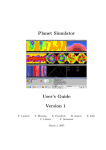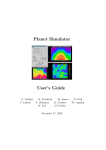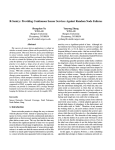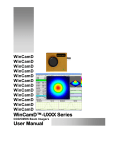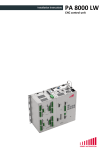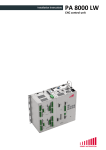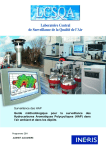Download Czech Technical University in Prague Spectroscopic Investigation of
Transcript
Czech Technical University in Prague Faculty of Nuclear Sciences and Physical Engineering Department of Physics Spectroscopic Investigation of Laser-Produced Plasma Interaction with Solid Targets RESEARCH PROJECT 2010 Michal Šmı́d Contents 1. Introduction 3 2. Elements of plasma radiation 2.1. Line spectrum . . . . . . . . . . . . . . . . . . . . . . . . . . . . . . . . . . . . . . . . . . . . . . . . . . 2.2. Satellite lines . . . . . . . . . . . . . . . . . . . . . . . . . . . . . . . . . . . . . . . . . . . . . . . . . . 4 4 4 3. Double-foil experiments 6 4. Instrumentation 4.1. Vertical-geometry Johann spectrometer . . . . . . . . . . . . . . . . . . . . . . . . . . . . . . . . . . . 4.2. X-ray streak camera . . . . . . . . . . . . . . . . . . . . . . . . . . . . . . . . . . . . . . . . . . . . . . 7 7 8 5. Theoretical spectra 5.1. Opacity broadening . . . . . . . . . . . . . . . . . . . . . . . . . . . . . . . . . . . . . . . . . . . . . . . 5.2. Comparison of various simulation codes . . . . . . . . . . . . . . . . . . . . . . . . . . . . . . . . . . . 5.3. Method of experimental and theoretical spectra comparison . . . . . . . . . . . . . . . . . . . . . . . . 12 12 15 15 6. Si02 experiments 6.1. Rotation of targets . . . . . . . . . . . . . . . . . . . . . . . . . . . . . . . . . . . . . . . . . . . . . . . 17 17 7. LPWI experiments evaluation 7.1. Comparison to 3Ω experiments. . . . . . . . . . . . . . . . . . . . . . . . . . . . . . . . . . . . . . . . . 7.2. Fitting with theoretical spectra . . . . . . . . . . . . . . . . . . . . . . . . . . . . . . . . . . . . . . . . 22 22 22 8. Conclusion 29 A. VJS A.1. A.2. A.3. A.4. A.5. Analyser manual Introduction . . . . . Image manipulation Analyzing procedure Data export . . . . . Configuration . . . . . . . . . . . . . . . . . . . . . . . . . . . . . . . . . . . . . . . . . . . . . . . . . . . . . . . . . . . . . . . . . . . . . . . . . . . . . . . . . . . . . . . . . . . . . . . . . . . . . . . . . . . . . . . . . . . . . . . . . . . . . . . . . . . . . . . . . . . . . . . . . . . . . . . . . . . . . . . . . . . . . . . . . . . . . . . . . . . . . . . . . . . . . . . . . . . . . . . . . . . . . . . . . . . . . . I I I III IV V B. CompSpect manual B.1. Introduction . . . . . . . . . . B.2. Application description . . . B.3. Usage guide . . . . . . . . . . B.4. Keystroke function reference . . . . . . . . . . . . . . . . . . . . . . . . . . . . . . . . . . . . . . . . . . . . . . . . . . . . . . . . . . . . . . . . . . . . . . . . . . . . . . . . . . . . . . . . . . . . . . . . . . . . . . . . . . . . . . . . . . . . . . . . . . . . . . . . . . . . . . . . . . . . . . . . . . . . . . . . . . . . . . . . . . . . . I I I II III . . . . . . . . . . . . . . . . . . . . 2 1. Introduction The interaction of plasma with solid materials is of large importance for basic research studying the properties and behavior of hot plasmas. It is also important because of its possible applications in future fusion devices. For example, in tokamaks used in magnetic confinement fusion, the plasma diffuses despite the magnetic gradient from the inner parts towards the outer parts of the tokamak. Consequently it reaches its wall and interacts with it. This is one example of the occurrence of plasma-wall interaction, which is intensively studied. In the most common scheme of indirectly driven inertial confinement fusion we can see another example of plasmawall interaction: The fusion pellet is inserted in the hohlraum, the inner surface of which is irradiated with laser beams to produce a plasma which interacts with the pellet. The laser–produced plasma is a plasma generated using an intensive laser beam. The laser beam impinges on a solid target, typically a thin foil, where the matter is ionized and a plasma jet perpendicular to the target is produced. This represents a very efficient tool for investigating the plasma-wall interactions, because the expanding plasma jets can produce different interaction scenarios. A very efficient diagnostics of such plasmas is based on the x-ray emission spectrometry. The aim of this document is to describe the laser-plasma wall interaction experiments performed in PALS laboratory, which are directed to the acquistion of experimental data necessary for verification of theoretical models of plasma wall interactions and which should contribute to the understanding this phenomena. The main diagnostic tool in those experiment was the vertical-geometry Johann spectrometer (VJS), as described further, which records the high-resolution, spatially resolved spectral data on an x-ray film. The processing of the recorded spectra from VJS was the main part of my bachelor work. It consisted of calibrating the scanner and developing a software package for spectra reconstruction. During the research project I investigated the possibilities of using theretical spectra for plasma diagnostics and developed a new code for spectra comparison. 3 2. Elements of plasma radiation The radiation emitted from hot dense plasmas is probably the most important diagnostic tool for these plasmas, because it carries information about the local plasma conditions. For short life-time plasmas, that we focus on in this thesis, the x-ray radiation is a very efficient diagnostic tool.[1] The emission spectrum is produced by electron transitions, which can be classified with respect to the initial and the final transition states to free-free, free-bound, and bound-bound transitions. It is obvious that the photons emitted during the first two types of processes contribute to the continuous spectrum, while the latter process produces photons with discrete energy spectrum and therefore contributes to the line spectrum. 2.1. Line spectrum The line spectrum occurs only in plasmas where ions are not fully stripped. In hot dense plasmas, that we are concerned, this is true only for the intermediate and high-Z plasmas. The main process contributing to the line spectrum is the spontaneous decay in which an excited ion decays into a lower, usually ground state, emitting a photon with energy corresponding to the difference between the two electron states. The energies of those lines are given by the Bohr formula, Z 2 e3 1 1 E= − 2 , (2.1) 2a0 n2l nu where nl and nu are the principal quantum numbers of the lower and the upper state of the transition. For the hydrogen-like ions (that is ions with only one bound electron left), the lines are organized into series according to the final state of the transition. The series are denoted by names, as seen in table 2.1. The lines from each series are denoted with a Greek letter in its subscript, e.g. Lyα refers to nl = 1 and nu = 2. 2.2. Satellite lines Satellite lines constitute another part of the line spectrum. Usually they appear as low intensity lines near strong parent lines. They are caused by the decay of double– or multiply–excited ion. If one of the excited electrons of a multiply-excited ion decays into a lower state, it emits a photon with energy similar to that emitted from the same transition in a single-excited ion. The presence of another excited electron, so called spectator, slightly modifies the electric potential of the ion and thus the energy of the transition levels and the wavelengths of the emitted photon. This means that for each configuration of states of spectator electrons, there is a separate satellite line. Near the Lyα transition in hydrogen-like ions, the satellite lines corresponding to different states of the spectator electron are distinguished by the capital letters. In our measurements we have focused on the J satellite, which is produced with the spectator electron in one of the 2p states. The main diagnostic advantage of satellite lines is their sensitivity to plasma parameters (electron density and temperature) and their small reabsorption compared to the resonance line photons. Each photon emitted during radiative decay can be reabsorbed by the inverse process, the resonant photoabsorption. The rate of this process (the number of photons of given energy absorbed per unit time per unit volume) is proportional to the density of ions in the lower state of the corresponding transition. This means that a photon emitted due to a decay of single excited ion into its ground state can be easily reabsorbed because the density of ions in the ground state is relatively large. In contrast, the satellite-line photons are almost never reabsorbed because the density of the excited ions, which are necessary for the reabsorption, is rather low. To sum up, the photons of resonance lines are often reabsorbed and reemitted during the transfer from the plasma center to the detector (thus mostly carrying information about the plasma edge), while the satellite lines carry information directly from the place they have been first emitted. The multiple-excited ions can originate in several processes. One of them is the dielectronic recombination, when a free electron is captured into an ionic excited state and the released energy is transfered to the bound electron, which series Lyman Balmer Paschen Brackett abbrev. Ly Ba Pa Br ... nl 1 2 3 4 Table 2.1.: Names of spectroscopic series 4 2. Elements of plasma radiation is then also excited. The other way is the impact excitation, which may occur twice or more times in a short time period, thus resulting in the multiple excitation of the ion. 5 3. Double-foil experiments Here we describe the basic scheme of the double-foil laser-plasma interaction experiments, which forms a basis of our project. The principle of the experiment consists in laser irradiation of the target placed in a vacuum vessel, and the analysis of the x-ray emission accompanying the laser-matter interaction. The target consists of two thin intermediate-Z foils (usually 0.8 µm Al and 2 µm Mg) with variable spacing (usually 200 − 500 µm). As the laser beam impinges on the target, it produces a plasma on the first irradiated foil. The plasma jet expands perpendicularly to the foil surface at both its sides. With respect to the experiment configuration used, there are two possible scenarios: 1. The plasma jet collides with the relatively cold second foil. 2. The laser beam burns through the first foil and impinges on the second foil before the first-foil plasma reaches it. Consequently, there is already a plasma plume produced on the second foil before arrival of the plasma jet and we observe the collision of those two plasmas. The occurrence of one of these scenarios depends mainly on the laser-foil geometry, first foil thickness and composition, and on the laser beam parameters. In some experiments, an auxiliary counter-propagating laser beam can be focused on the second foil from the other side to preheat it and thus to vary the conditions of plasma interaction. The most relevant diagnostics for these experiments is based on an analysis of the emitted x-ray radiation. There can be several types of tools providing temporal, spatial or spectral resolution or its combinations. 6 4. Instrumentation In this chapter we describe the instrumentation used in the double-foil experiments performed at the PALS Research Center in Prague [2]. The PALS main laser beam is capable of delivering up to 1 kJ of energy at the fundamental wavelength 1.315 µm, which can be tripled to 438 nm. The pulse length is 250 - 300 ps. We used two main diagnostic tools: the VJS provided high-resolution spatially-resolved spectral data, and an x-ray streak camera combined with the slit provided spatially and time -resolved measurements of plasma expansion. 4.1. Vertical-geometry Johann spectrometer The vertical-geometry Johann spectrometer (VJS) is an x-ray spectrometer based on the principle of vertical dispersion. It provides a high-luminosity, high-resolution, one dimensionally spatially resolved spectral data. Here we will describe the basic principles of VJS, for further reference see [3], [5]. Figure 4.1.: Rowland circle scheme. The main element of VJS is a cylindrically bent crystal, which defines a Rowland circle (RC). Neglecting the focusation defects, the Rowland circle scheme (Fig. 4.1) guarantees that any ray going from the point on this circle to the crystal is reflected to another point on the RC, which is symmetrically located along the crystal axis. This means that if the radiation is emitted from a line source lying on the RC, it is reflected and focused to the corresponding line on the RC, where a detector can be placed. In concrete experiments, neither the source nor the detector are positioned perfectly on the RC; for elongated sources, both the source and the detector are perpendicular to the central ray connecting the relevant point on the RC with the crystal center. The dispersion is realized in the vertical direction (i.e. perpendicular to the RC plane). It is based on the Bragg’s law, which states that only photons with the wavelength λ corresponding to the glancing angle θ are reflected, according to the formula 2d sin θ, (4.1) λ= n where d is the spacing parameter between diffraction planes of the crystal and n is the spectroscopic order. In our experiment, we used a crystal with the crystal spacing 2d = 0.85084 nm and the bending radius of r = 76.6 mm. The spectroscopic order was n = 1. As the detector, x-ray film Kodak CX was used. The schematic drawing of the VJS setup can be seen in Fig. 4.2. There is a line source on the right side of the image, which emits radiation towards the cylindrically bent crystal in the center of the image. The radiation is reflected towards the detector (on the left), where the film with recorded spectrum is drawn. In the spectrometer there is also a beam stop (not shown in the picture) preventing radiation to go directly from the source to the detector. Figure 4.3 shows a typical scanned film from VJS with the spectrum recorded. The vertical axis of the image corresponds linearly to the spatial position of the emitted spectra, the horizontal axis corresponds to the wavelength with a more complicated relation (A.4). The dominant horizontal shape represents a strong radiation emitted from the laser-irradiated foil. The conic-like lines are the spectral lines emitted at different distances from the foil surface. Their special shape is due to the VJS geometry. 4.1.1. VJS spectra reconstruction The films with spectral records (shown in Fig. 4.3) need to be digitized, calibrated and recalculated to get relevant spectral data. The digitization can be performed using a precise but not easily available two-dimensional densitometer. As an alternative to this process we have used a tabletop scanner Epson Perfection V700 with the capability of scanning the films. 7 4. Instrumentation Figure 4.2.: Schematic drawing of the VJS setup. First, it was necessary to calibrate the scanner to the optical density, which can later be recalculated to real exposures by using the known characteristic curves of the film. To get this calibration, we scanned the calibration wedge delivered by the x-ray film producer (Kodak). The measured values stored in the tiff format were fitted with the logarithmic function (because of the logarithmic definition of the optical density). The resulting parameters of this fit were used for the spectra reconstruction. The found dependence of the optical density on the scanned tiff value is seen in Fig. 4.4, where the points denote measured data and the line denotes their logarithmic fit. For handling the scanned films and the spectra reconstruction we developed a special software package, the VJS Analyser, which is described below. 4.1.2. VJS Analyser VJS Analyser is a software package which was developed for the reconstruction and the analysis of the spectral data from VJS. It is written in the Java language. Only the main features and capabilities of this application are described here. The details of VJS Analyser can be found in its user manual (appendix A). The illustrative picture of VJS Analyser in its spectra viewing mode can be seen in Fig. 4.5. The input of this application is the scanned film data file or an equivalent file from densitometer, in format of 16-bit gray-scale tiff image. The main functions of VJS Analyser include: • Viewing and basic manipulation of 16-bit gray-scale tiff images. • Precise measurement of the spectral data tilt using correllation algorithm based on the data symetry. • Precise determination of the spectral line positions using the least square fit of the appropriate profile. • Spectra reconstruction - conversion of the raw data into a set of calibrated spectra. • Viewing and browsing of reconstructed spectra. • Exporting the selected part of spectral data into a 2D plot suitable for elementary analysis or presentation. • Exporting the spectral data into tables suitable for further analysis. 4.2. X-ray streak camera Streak camera is a device providing data with high temporal resolution. It transforms the temporal profile of the measured signal into a 2D spatial profile on a detector. The radiation passing through the entrance slit of the streak camera is converted into electrons and then they are deflected using a strong 1D time-variable electric field. The other dimension is left unchanged, so we get an image with one axis corresponding to time and the other axis corresponding to the spatial distribution of the measured signal. We used Kentech low-magnification x-ray streak camera with temporal resolution 2.03 ps/pixel and spatial resolution 2.9 µm/pixel. An image from this streak camera can be seen in Fig. 7.3. 8 4. Instrumentation Figure 4.3.: Typical scanned film from the VJS with the spectrum recorded. 9 4. Instrumentation Figure 4.4.: Scanner calibration - the relation between the scanned tiff values and the optical density. Points represent the measured values and the line is the fitted calibration function. 10 4. Instrumentation Figure 4.5.: Preview of the spectra analysing regime of the VJS Analyser. 11 5. Theoretical spectra Theoretical x-ray emission spectra of hot dense plasma provides a very powerful tool for plasma diagnostics. The measured experimental data can be directly compared to a set of theoretical spectra and thus the free parameters of the simulation can be estimated. The cruical part of the spectra synthetization process is the calculation of plasma population distribution, which can be calculated using several models used for different regimes of plasma parameters. The Coronal equilibrium model (CE) gives the best results for diluted plasmas, while the local thermodynamical equilibrium (LTE) model is useful for dense, equilibrium matter. For our purposes, the intermediate Collisional Radiative model (CR, or non-LTE) is the only possible choice because it can handle non-equilibrium plasmas within huge range of densities[1]. While the first two models get the population distribution from basic principles, the CR model formulates a set of rate equations [8] X X dni = −ni Wij + nj Wij , (5.1) dt j,j6=i j,j6=i where ni is the ion population in the ith state, and the Wij is the transition coefficient between the atomic states i and j. This coefficient is a sum of rates for all included atomic processes, and may be dependent on plasma parameters, population of atomic states and radiation intensity. These equations need to be completed with the radiation transport equation, which is a relation between the intensity of radiation in each point of plasma and the plasma emisivity and absorptivity coefficients (which indicates the radiation emission and absorption, respectively, of given wavelength per unit time and volume), which are dependent on ion population distribution. These two sets of equations need to be solved numerically together. The radiation transport can bring new effects to experimental spectra, which do not follow from simple dimensionless theories, like opacity broadening or other line-shape modifications. 5.1. Opacity broadening In this section, I would like to give a brief description and explanation of the opacity broadening, one of the simplest and most noticable effects of the radiation transport. The radiation transport equation can be simplified for stationary homogenous 1D plasma as[6] ε dI = − I, dτ κ where ε(ν) and κ(ν) are the emissivity and absorptivity, τ (z, ν) is the optical depth defined as τ (z, ν) = with the spatial coordinate z, and the I(ν, z(τ )) is the radiation intensity. The solution for plasma with thickness L is I= ε ε (1 − e−τ ) = (1 − e−κL ). κ κ (5.2) Rz 0 κ(z 0 , ν)dz 0 (5.3) For radiation with low optical depth (τ = κL 1), the exponential can be expanded into lowest orders Taylor series and the equation is simplified as I = εL, (5.4) thus the emission is proportional to emissivity; for optically thick lines, the emission is decreased by the exponential function and the intensity is limited by the factor κε , called the source function, which is, for LTE plasmas, equal to the black-body radiation, thus not having the significat spectral dependence as emissivity or absorptivity. This explains why the intensity of strong spectral lines, which have large optical depth, is decreased due to their reabsorption on its way throguh the plasma, while the optically thin satellite structure is unperturbed. The effect is illustrated on theoretical profiles of Si02 plasma with ion density ni = 8 × 1020 cm−3 , temperature T = 350 eV, and thickness L = 100 µm, relevant to experiments described in chapter 6. Fig. 5.1(a) shows the emissivity, which corresponds to the emission intensity for thin plasmas. Fig. 5.1(b) shows the optical thickness, (and also the absorptivity, because they are proportional to each other.) The optical depth of Si02 Heα resonance line (at ∼ 6.18 Å) is ∼ 10 thus this transition is strongly affected by the reabsorption, while for the satellite structure with depth less then ∼ 0.1 the optically thin limit can be used. Fig. 5.2 shows the emission profile of the plasma (with linear scale in contrast to previous profiles) with the resonant line reabsorped, thus decreased. The huge difference between satellite and parent intensities in the absorptivity profile (compared to emissivity profile) is caused by the fact that the absporption of light with the satellite-line wavelength is done on excited ions, which have much less populations in plasma than ground state ions need for resonance-line absorptions. 12 5. Theoretical spectra (a) (b) Figure 5.1.: Emissivity (a) and absorptivity (b) of Si02 plasma with T = 350 eV, ions ni = 8 × 1020 cm 3 . Figure 5.2.: Intensity spectrum of 100 µm thick plasma. 13 5. Theoretical spectra Figure 5.3.: Comparison of fitted theoretical profiles; Experimental spectra (black triangles) were fitted using Maria code (blue line) and PrismSpect code (red line) . 14 5. Theoretical spectra 5.2. Comparison of various simulation codes For our evaluation we could use the FlyCHK and PrismSpect codes. By direct comparison of relevant theoretical spectra produced by these codes we realized, that the PrismSpect comprises more atomic data as demonstrated in more complex satellite structure, so we decided to use this one. Second step was to compare the selected code PrismSpect with the Maria code that was used in previous publications[7] to acquire parameters from the LPWI experiments performed in 2006, so we fitted the same experimental data using the PrismSpect theoretical spectra and compared the resulting parameters. In Fig. 5.3 there are three experimental spectra (black triangles), fitted using the Maria code (blue line) and using the PrismSpect simulations (red lines). The temperature and electron density of the fits are in talbe 5.1. The Maria simulations were performed on plasma with various thicknesses and considering plasma gradients, while the PrismSpect simulations were performed on homogenous, 100 µm thick plasma. The result of the comparison is quite satisfactory, the differences between plasma parameters are acceptable. spectra T [eV] (a) (b) (c) 300 700 220 Maria ne [e/cm3 ] 3 × 1021 3 × 1020 (1 ÷ 3) × 1021 PrismSpect T [eV] ne [e/cm3 ] 460 760 220 1 × 1022 1 × 1021 5 × 1021 Table 5.1.: Parameters of Maria and PrismSpect fits. 5.3. Method of experimental and theoretical spectra comparison Although the PrismSpect code has the capability to compare simulated and experimental spectra, it is not suitable to find the best fitting theoretical spectrum to selected experimental one, so I have developed a new application for this purpose, called CompSpect. The PrismSpect provides funcionality of creating a set of spectra with various temperatures and densities. This set is loaded into the CompSpect application as well as the experimental data, which can be either single spectrum, or a set of spatially resolved spectra, eg. from the VJS Analyser code. The application uses a least square method to determine which simulated spectra is best fitting to the experimental one. However, this method did not gave sufficient results so a possibility to easily select the best spectra manually was also included. Though the original idea was to improve the fitting algorithm to search the best spectra autmatically with good enough results, finally I realized there were serious reasons why it would be too complicated, so in current version the use of automatical search is recomended only as an initial fit for manual search. The reasons were: • Difficulties with determining the minimum and maximum intensity in the spectra caused by noise. • In some cases it is more important to fit the integrated intesity of a line, than its whole profile. This is not possible to perform using least square fit, instead of it it would be necessary to perform spectra deocmposition. • Different parts of spectra may have various importance (weights) for fitting. • In spatially resolved spectra, we use the assumption of continuous and/or monotonous evolution of plasma parameters with distance, which would be more difficult to implement in automatic fitting. The preview of main window of CompSpect application is in Fig. 5.4. It is a Java application, so it can be used on any computers hosting a Java Virtual Machine. Its user manual is in appendix B. 15 5. Theoretical spectra Figure 5.4.: Screenshot of the CompSpect application. 16 6. Si02 experiments This chapter describes a set of experiments performed in January 2009 with prof.Limpouch in PALS laser laboratory, which were evaluated using the spectra fitting method as described above. The experiments were similar to those described in chapter 3, the main difference was in the target material and structure. Here we used two types of Si02 targets: 1. Massive Si02 target. The laser focal spot had diameter 80 µm. 2. Si02 dot with diameter 100 µm and thickness 1 µm fixed on a poly(methyl methacrylate) (PMMA) base. Focal spot was ∅ 250 µm. The target was irradiated by the PALS main beam with puls length ≈ 250 ps, wavelength λ = 1.315 µm, energy ≈ 70J and focal spot various for different targets. The main diagnostic tool was the VJS spectrometer, set up to observe the Heα or Lyα lines with their satellite structures, and providing spatial resoultion along the laser axis. The VJS spectral record from one of the dot target experiments is shown in Fig. 6.1. The preview of its spectrum in distance 16 µm from the surface compared to assigned theoretical one is in Fig. 6.2. The CompSpect code was used to assign plasma parameters using spectra fitting to profiles from various distances from the target surface. The resulting temperature and density profiles for the massive target and for the dot target experiments are in Fig. 6.3. In both profiles we can see a significant decrease in density and almost linear increase of temperature with distance from the target. The main difference between both variants of experiments is the greater increase of temperature in the massive target experiment, which may be caused by two reasons: • Higher intensity of the laser. (The same total intensity was focused on smaller diameter.) • The massive target could absorb the whole duration of laser pulse, while the 1 µm thin Si02 dot absorped only part of the pulse before it get ionized and diluted. In the dot target experiment, the plasma radiation was observed till higher distances from the target (up to ∼ 100 µm), which can be explained by confining of the Si plasma with surrounding PMMA plasma. (The Si02 plasma could not spread in directions perpendicular to laser axis.) 6.1. Rotation of targets Some experiments from this series were performed with target rotated 30◦ to laser axis, towards direction of spectra observation, to analyze the possibilites of similarly rotated double-foil LPWI experiments. According to simulations [7], the plasma should stream perpendicular to the target surface, so the rotation of the target should be measureable through the doppler shift of the lines. The measurement was performed on the optically thin J-satellite, because it is not reabsorped, thus giving us information from the whole plasma stream, while the observed emission of the resonance line is produced mainly in the plasma edge. The point of the measurement was to take two similar shots with different target rotation and measure the difference in J-satellite wavelength. The typical approach of VJS calibration (to define a wavelength of one line) was useless here, because for this purpose there was no line unaffected by the target rotation and thus by the doppler shift. We used a fact that VJS provides two symetrically located set of spectra (as illustrated in Fig. 6.4), and for the distance z between two records of one spectral line with wavelength λ there is a relation (as described in VJS Analyser manual in Appendix A) λ z = 2l tan(acos( )), (6.1) λ0 (y) where l is the plasma – crystal – detector distance, λ0 (y) is the wavelength corresponding to the central point on the film in given spatial position y and should be the same for both experiments, if the experimental setup is kept untouched. The measured distances were zp = 19.05 mm for perpendicular target and zr = 19.48 mm for rotated target, so the difference is ∆z = 0.43mm. The λ0 was calculated from the (6.1) with the tabulated value of J satellite λ = 6.7422 Å and z from the perpedicular experiment, which is unperturbed by the Doppler shift. Distance l is l = 121.928 mm. This gives the λ0 = 6.7627 Å and with this value we get the wavelenegth for rotated target as λr = 6.7412 Å, getting the perturbation of wavelength as ∆λ = λ − λr = 0.97 mÅ. 6.1.1. Uncertainty estimation We identified three sources of uncertainties in the peak distance measurement: 1. Unprecise idnetification of the target surface on the scanned film; The distance between lines is strongly dependent on the y coordinate on the film. For given wavelength and position the change of distance z with position dz y is dy ≈ 17. The uncertainty of correct identification of surface position is approximately 1 px on the scanned film, that is ∼ 6 µm, so we get uncertainity 1 = 0.1 mm 17 6. Si02 experiments Figure 6.1.: Spatially resolved spectra from the VJS spectrometer for the Si02 dot experiment. Figure 6.2.: Experimental profile (black dots) and the best fitted simulated spectra (red line) from the Si02 dot target experiment, 16 µm from the target surface. 18 6. Si02 experiments Figure 6.3.: Temperature and density variations with distance in Si02 experiments, for two types of targets. 19 6. Si02 experiments Figure 6.4.: Raw VJS record of the Si02 dot experiment. 20 6. Si02 experiments 2. Position of the target; Possible imprecision of target positioning was estimated as 10 µm, the effect of target position would affect the distance the same way as its unprecise identification mentioned above, this source gives 2 = 0.01 × 17 = 0.17 mm. 3. Measurement of the distance between lines; Cruical problem of the distance measurement was precise peak idnetification, which was complicated due to overlap of two lines, the uncertainty was estimated as 3 = 0.1 mm Adding these uncertainties, we get ∆z = 0.3 ± 0.2 mm. Converting to wavelength scale using (6.1) we get ∆λ = 1.0 ± 0.4 mÅ. (6.2) This gave us important information on the possibilities of similar measurements in the ongoing summer 2010 experiments. The Doppler shift relation ∆λ = λ sin(α) vc implies the plasma near surface velocity v ≈ 105 m s , which is well in agreement with 1D hydrodynamic simulations of similar arrangement[4]. 21 7. LPWI experiments evaluation In this chapter we present the evaluation of the LPWI epxeriments performed in January 2009, as described in chapter 3. In the first section we present a basic description of measured data and their comparison with older experiments, as was written for my bacheolr thesis, while in the second section we apply the methods of theoretical spectra fitting and present its results, as a original work for my research project. 7.1. Comparison to 3Ω experiments. We compare the 2009 experimental results with the similar one performed in 2006, described in [7]. Both experiments used double foil targets irradiated from the Al side only. The VJS was set to measure the Al Lyα resonance line with its satellites, especially with the J satellite at 7.2759 Å. Table 7.1 compares the most important experimental parameters. The reconstructed x-ray spectra are shown in Figures 7.1 and 7.2. Target material Foil spacing Laser beam intensity Laser beam frequency 2006 2009 Al/Mg 350 µm 79 J 438 nm Al/Al 450 µm 112 J 1315 nm Table 7.1.: Comparison of the experimental parameters. In the lower part of Fig. 7.1 (2006 experiment) we can see spectra emitted from the Al foil (positioned at the distance of 0 µm) and those close to the Mg foil viewed on the top (at ∼ 350 µm). The outer couple of intensive lines corresponds to the resonant Al Lyα line, the less intensive couple in the middle (at ∼ 7.27 Å) to the J satellite. We can see the emission of the full group of the satellite lines from the Al foil, their disappearance at about 150 µm and their reappearance at the Mg foil. This corresponds well to the record from the streak camera (Fig. 7.3), where the emission from the first foil starts at ∼ 0.2 ns, and at ∼ 1 ns occurs the interaction of the Al plasma with the plasma generated from the Mg foil. The spectra shown in Fig. 7.4 (2009 experiment) correspond to the altered experimental configuration. The striking differences include: • The gap in the line emission close to the position of the Al foil. This is explained by a small tilt of this foil, which partly blocks the radiation. (The laser beam was focused at the distance of approximately 200 ÷ 500 µm from the foil edge.) • The spectral lines display distinct second maximum in between the foils (at ∼ 200 µm), while close to the second foil they do not reappear so significantly. The strong emission at the midplane of the foils is again explained by a collision of two counter-streaming plasma jets. The plasma jet from the second foil was produced by the laser beam that burned through the first foil. The observed difference corresponds to the diverse experimental conditions, in particular to the significant difference in laser frequency, which alters substantially the mechanism of energy deposition in the foils. To summarize, in the first experiment the plasma jet collision with relatively cold Mg foil was observed, while in the second one we had observed the collision of two plasma jets. 7.2. Fitting with theoretical spectra For this evaluation, we took an Al/Mg target experiment, with laser energy E = 193 J. The record from VJS spectrometer is shown in Fig. 7.4, the significant profiles from this data are drawn and described in Fig. 7.5. In the lower part of Fig. 7.4 we can see spectra emitted from the Al foil (positioned at the distance of 0 µm), and those close to the Mg foil viewed on the top (∼ 550 µm). The outer couple of intensive lines corresponds to the resonant Al Lyα line, the less intensive inner couple on the Al foil to the Al Ly J-satellite(∼ 7.27 Å). The horizontal line with no radiation at ∼ 0 µm is the shade made by the the unperturbed part of the Al foil. We can see the emission of the full group of the satellite lines from the Al foil spreading and damping on both its sides, and their intensification at ∼ 200 µm, where they are also mixed with the Mgδ (∼ 7.31 Å) and Mg (∼ 7.22 Å) lines due to the collission of the counter-streaming plasma jets and consequently the density buildup in this region. The Al emission structrue disappear above ∼ 500 µm, except for the weak J-satelliteand the resonance line. On the Mg foil (∼ 550 µm), we can see distinct Mg lines, as well as the Al J-satelliteand the resonance line, which gave a clear evidence of Al plasma penetration into this region. 22 7. LPWI experiments evaluation distance [µm] 21 95 344 555 Material Al Al Mg Mg T [eV] nm [g/cm3 ] 300 480 200 200 0.02 0.01 0.005 0.02 Table 7.2.: Parameters of Maria simulation spectras fited onto LPWI experiment. In Fig. 7.5 there are five selected distinctive spectra from the measured range, fitted with PrismSpect simulation profiles with plasma parameters summarized in Table 7.2. It shows a typical plasma diluting with increasing distance from both foils. The effect visible on Mg Heδ line at 555 µm may be caused by the non-homogenity of the plasma, where the optically thick resonance line is reabsorped with smaller line width then it was emited[6], thus producing the specific splited shape of the line. The midplane spectrum (190 µm) shows Al emission as well as the Mg He line. The Mg Heδ line is not visible because it is out of the spectrometer range in this position. (The measured range of VJS varies with the distance from target, as seen on Fig. 7.4.) The resonance line is strongly reabsorped, thus providing no relevant information, while the satellites shows distinctive line broadening, which may be caused either by higher temperature (>1 keV), higher density or plasma unhomogenity. The difficulties with fitting these data are produced mainly with the time and spatial integration. 23 7. LPWI experiments evaluation Figure 7.1.: Spatially resolved spectra of the 2006 experiment. 24 7. LPWI experiments evaluation Figure 7.2.: Spatially resolved spectra of the 2009 experiment. 25 7. LPWI experiments evaluation Figure 7.3.: Spatially and temporally resolved emission from the streak camera of the 2006 experiment. 26 7. LPWI experiments evaluation Figure 7.4.: Spatially resolved spectra of the LPWI experiment. 27 7. LPWI experiments evaluation Figure 7.5.: Selected spectra from LPWI experiment. 28 8. Conclusion The first part of this research project report summarizes very briefly the problematics of plasma-wall interaction and demonstrates the possibility of its studies through the double-foil laser-plasma wall interaction experiments. The basic properties of instruments used in relevant experiments are presented, and the results obtained by the novel code for reconstruction of the measured spectra are shown. The second part concerns the theoretical spectra simulations and their use as a diagnostic method, for which a novel code has been developed, and also its application for relevant LPWI experiments. I should emphasize that the measured high-resolution spectra can provide much more information on plasma interaction than the results discussed in this thesis. In particular, there is a substantial information potential in the satellite lines widths and positions depending on the spatial range of their emission. Further analysis of this data will be a subject of future investigation. My personal contribution to this topic can be summarized in few points: • Participation in experiments performed in January 2009. • Design of the alternative approach to the VJS spectra processing. That consists of the spectra digitizing including the scanner calibration, and of design, testing and application of the novel VJS Analyser software package for spectra reconstruction, including its manual for its easy use (appendix A). • Creating the easy-to-use codes for theoretical to experimental spectra comparing and fitting. • Applying these codes for basic evaluation of the 2009 LPWI experiments. 29 A. VJS Analyser manual A.1. Introduction VJS Analyser is an application which analyzes raw x-ray data recorded by VJS spectrometer, as described in [3]. It is written in the Java language, so it needs a working Java Runtime Environment (JRE) to run. It was developed in 2009 by Michal Šmı́d as a part of his bachelor thesis. The basic functionality of this application consists in manipulating and analyzing the recorded spectral data from VJS spectrometer (which should be 16–bit gray–scale tiff images) and exporting the resulting spectra into formats suitable for presenting and further analysis. In this manual as well as in the application we use the unit Ångström (1Å = 10−10 m) for wavelengths, because it is often used in literature. The contents of the software package is listed in table A.1. File Description vjsa.jar vjsa-run-linux.jar vjsa-run-windows.bat vjsa.conf vjsa manual.pdf lib subdirectory Application main file, executable through JRE. Launching script for Linux (see Section A.1.1) Launching script for Windows (see Section A.1.1) Configuration file(see Section A.5) This manual file. Directory containing necessary libraries. Table A.1.: Table of VJS Analyser package files. A.1.1. Launching the application The application is executable through the JRE. On some machines it may be possible to launch it by double-click the vjsa.jar file, but this way is not recommended because the JRE will not allocate enough memory for the application. The recommended way to launch the application is to type java -Xmx512m -jar vjsa.jar to the command line, which allocates 512 MB of memory for the application. Instead of typing this to the command line it is possible to run the vjsa-run-windows.bat on Windows machines or vjsa-run-linux on Linux machines. Both scripts only perform the command written above. A.1.2. Introduction to spectra reconstruction Schematic view of the spectra production using VJS and definitions of axis and individual variables is shown in Fig. A.1. Hereafter we use these symbols: CL, ZL calibration and zero lines 2d 2d crystal interplanar spacing parameter l Source to crystal to detector distance λc Calibration peak’s wavelength zl , zr Calibration peak’s left and right z-positions Use of terms horizontal and vertical is obvious from Fig. A.1 . A.2. Image manipulation VJS Analyser can handle basic image manipulation procedures. However, for advanced operations we recommend to use another graphic software (eg.: ImageJ 1 ). If there is any problem with image viewing, try choosing Other—Refresh 1 http://rsb.info.nih.gov/ij/ I A. VJS Analyser manual Figure A.1.: Simplified scheme of VJS. A.2.1. Viewing an image First, load desired image by choosing the Image—Load command. The image is drawn in the right pane and the View pane is shown. The viewing properties in this pane affect only the way the image is displayed on the screen. Those properties include: • Lightness slider: increases the lightness of dark images. The leftmost position means no change. • 8-bit only: increases the lightness by amount of 256, suitable if image is 8-bit only instead of recommended 16-bit. • Fit width: If checked, shrinks the image width to fit the screen, otherwise the image is shown in its actual size. A.2.2. Crop and Flip To crop an image, choose Image—Crop, then click into the image area to the point which will be the new upper-left corner, then to the one that will be the lower-right corner. Finally select Image—Crop again and the image will be cropped. The Flip (horiz.ax.) and Flip (vert.ax.) operations flip the image around the appropriate axis. A.2.3. Auto rotate This feature lets you precisely measure the image rotation using the correlation algorithm, and consequently rotate it. It is based on the fact that the raw spectral data image is symmetrical with regard to the vertical axis and two symmetrically located small areas which are almost identical can be localized. The algorithm searches the exact alignment of the left and right areas.This algorithm works fine only for images whose initial rotation is small (less then approximately 1◦ ). To use the auto rotation, follow these steps: 1. Select the Image—Auto Rotate command. 2. In the image, select the left of the two significant, symmetrically placed, areas. This area is shown in the bottom pane. 3. Select the right of those two areas. It is shown in the bottom pane next to the first one. If necessary, you can now proceed to point 2 again to correct your selections. 4. Select the Image—Auto Rotate command and the correlation is being processed. (It may take a while.) Its result is shown next to the areas with marked best correlation point. In the left area the best fitting point of the right one is also marked. In the Angle text field, the resulting angle is printed (in radians). II A. VJS Analyser manual 5. Now, you can either press the Rotate button to process the rotation of the image given by the angle written in the Angle text filed, or just use the measured value for realignment of the exposed film in film holder and scan it again. A.3. Analyzing procedure Before the analysis procedure can be performed, those conditions need to be fulfilled: 1. The raw data need to properly loaded 16-bit gray-scale image. 2. The raw data need to be precisely rotated into horizontal position. 3. The arch-like shape of the spectral lines must “point to the bottom” as seen on Fig. A.2. 4. The image needs to be cropped so that there are no borders of the film left. The analysis can be started by selecting the Image—Analyse command. The Analyse pane will appear. The numeric parameters should be set from the configuration file (see section A.5), but can be updated here. The horizontal lines are to be set here. Their setting is done using horizontal cursor (green line inside the image). This cursor can be moved using the up/down arrows, the page up/page down keys or the mouse. After the cursor is in desired position, press the appropriate button and the line number is written next to the button. Those horizontal lines are: 1. Top line - Above this line no spectra will be analysed. 2. Bottom line - Below this line no spectra will be analysed. 3. Zero line - This line defines the origin of spatial coordinate. (The surface/zero scan.) 4. Calibration line - The line where the calibration peaks will be searched at. Positions of those lines are shown in sample raw data image in figure Fig. A.2. In the bottom pane, the calibration lineout is drawn. The number of points of this lineout is given by the AnalyzingWaveRange parameter. The value of this parameter should be set sufficiently large to distinghuish well the details of the profile analyzed. To select the calibration peaks press the Set left or Set right button and click into the lineout in the bottom pane approximately at the peak position. The given mouse horizontal position will be used as an initial parameter for the fit of the line profile function into the spectra. The result of this fit is drawn with red color into the plot and its wavelength is written next to the appropriate button. If there is no line drawn into the image, it means that the fit did not converge. Finally, press the Process button and the analysis will be performed. The Data export pane will be shown. A.3.1. Details of spectra line fit The spectral lines are fitted using the least square algorithm. The fitting function f is the Gaussian profile modified to correspond the profile deformation given by the spectrometer geometry, f (z) = G(λ(z)), (A.1) where G(x) is the Gaussian profile G(x) = ae− (x−x0 )2 2σ 2 + b, and λ(z) is the function converting the z cooridinate defined in Fig. A.1 into the wavelength, z λ(z) = λ0 cos atan l (A.2) (A.3) where l is the source to crystal to detector distance and λ0 is the maximal wavelength in the current raw spectra lineout. During the fit, the parameters a, b, x0 and σ are being fitted, while l and λ0 are fixed. (l is the Distance analyzing parameter, and λ0 is computed from the analyzing parameters.) This complicated function is necessary, because the wavelength axis of the lineout is not linear and therefore the line profiles in the lineout are not symmetrical. A.3.2. Details of spectra reconstruction Here we describe the crucial routine of this application, the spectra reconstruction, which transforms the raw spectral data in the scanned image into a set of spectra. III A. VJS Analyser manual A.3.2.1. Preparation 1. Each pixel of the image is converted into the light intensity using formulae (A.6) and (A.9). (see sections A.5.3 and A.5.4) 2. z0 = zl +zr 2 is the vertical central position in the raw data. 0 ) is the vertical divergence angle of the ray defined by the source and the calibration peak 3. ϕc = atan( zr −z l positions. λc 4. θ0 (CL) = asin( 2d cos(ϕ ) is the Bragg angle (the glancing angle of incidence on the crystal) of the central ray c )) defined by the symmetry axis of the calibration lineout. A.3.2.2. Transformation For each spectral lineout within the top and bottom lines (corresponding to a given y), the following is performed: 1. ∆y = (CL − y) is the horizontal distance from the calibration line. 2. α(y) = atan( 2l ∆y ) is the horizontal divergence angle of the ray going from the crystal to the detector. 3. θ0 (y) = θ0 (CL) + α(y) is the Bragg angle of the central ray in the lineout defined by the y coordinate. 4. λ0 (y) = 2d sin(θ0 (y)) is the wavelength corresponding to the spectrum symmetry axis in the y line. The wavelength range covered in the spectrum studied is split into a set of equidistant intervals. The width of each interval is given by the ExportWavelengthStep parameter. The z-coordinates of the interval boundaries are computed using equation z = z0 ± l tan(acos( λ )), λ0 (y) (A.4) where the ± sign differs the left and the right hand spectra. Note that while on the wavelength scale the intervals are equidistant, in z coordinates they are not. Generally, there are more data points in the same wavelength interval positioned close to the spectra symmetry axis, i.e. at the longer wavelengths. A.4. Data export After the analysis is performed, the Data export pane is shown and the reconstructed spectra is drawn in the right pane. In this phase you can examine the spatially resolved spectra, and export them into tables and easily readable images. All types of export use the current values of the parameters minimal and maximal wavelength, and wavelength step, as set in the text fields in the left pane. With respect to these parameters, only the interval given by the minimal and maximal wavelength is exported, and the interval between each two neighboring exported pixels/points is given by the wavelength step parameter. The total number of exported pixels/points is then computed as number of points = λmax − λmin + 1, s (A.5) where λmax , λmin , and s are the parameters minimal and maximal wavelength, and wavelength step. The export directory, into which the tables and plain images are exported, can be set using the Change button. A.4.1. Export as tables Exports the spectrum under current cursor position as two separated files, lxxx.dat and rxxx.dat for the left and the right hand part of the evaluated spectrum, respectively, where xxx denotes the spatial position of the spectrum written in 3 digits in µm. The files are saved into the export directory. The tables are simple text files, where each row corresponds to one point in the spectral plot and has a format Wavelength <tab> Intensity. A.4.2. Export as plain image Exports data into the file PlainImage.tif, which is a 2D plot, with the X-axis corresponding to the wavelength [Å] and the Y-axis to the position [ µm]. Each pixel value represents a radiation intensity with corresponding wavelength and position. The information about the scale and the calibration of the image is in the plainImageInfo.txt. Both files are saved into the current export directory. IV A. VJS Analyser manual A.4.3. Export as labeled image Exports a 2D image similar to the plain image, but optimized for presenting. After the button is pressed, the save dialog appears to ask for the desired filename of the image, i.e. disregarding the export directory. The new features of the labeled image include: • Intensity mapping to colors. (Using internally built colormap.) • Labels on edges of the image. (with tick and text intervals defined using the Image...Int parameters) • The image quality enhancement using the inteliBlur option (which is applied if the checkbox is checked). This option performs a kind of selective blur, which is optimized for the noise that can be present in the image. A.4.4. Examining spectra The horizontal cursor can be moved similarly as in the previous phase, using the up/down arrows, page up/page down keys or the mouse. The actual spectral record is shown in the bottom pane and its spatial position (distance from the zero line) denoted as y is written in the left pane (in µm). To examine the spectra, you can click into the lineout in the bottom pane and the wavelength corresponding to the mouse position and the intensity in this position is written in the left pane. The intensity is in the same units as those given in the calibration formula (A.9). A.5. Configuration This application is configured through the configuration file, which sets the values of several parameters. Because most of them are specific for each experiment, we recommend to have one configuration file for each experiment setup and just copy the appropriate file in the application directory. The file is loaded when launching the application. If the configuration is changed during the application run, the modified configuration file can be reloaded using the Other—Reload configuration command. A.5.1. Table of parameters Table A.2 sums up all application parameters, their default or recommended values, their description, and a reference to a section in this manual. The parameters written in bold letters can be set during the analysis process (their values stated in the configuration file are considered as default values only), the others must be defined in the configuration file. A.5.2. Configuration file syntax The calibration file named vjsa.conf is located in the same directory as the program vjsa.jar file. It is a plain text file. Each row represents one parameter assignment. All rows beginning with the number sign (#) and empty rows are ignored. All values are float, except pixel unit values, which are integers. A preview of calibration file can be seen in Fig. A.3. A.5.3. Scanner calibration The relation between the measured optical density (Dm ) of the scanned material and a pixel value in a scanned tiff file (v) is generally given by Dm = −a log10 (bv + c) + d, (A.6) where the constants a . . . d need to be measured for the current scanner and set into the configuration file where they are listed as oda. . . odd. A.5.3.1. precalibrated data The application can also handle data from devices which are already calibrated to the optical densities. In this case, it is necessary to switch the precalibrated option to true. That means that in the configuration file should be line containing precalibrated = 1 and the optical density of the film (Df ) is get from the equation Df = a + bv, (A.7) where a and b are the calibration constants oda and odb and v is the scanned tiff file value. Note that in this regime, the film base subtraction (equation A.8) is not performed. A.5.4. Film calibration The film calibration relates the recalculation of the photon fluxes impinging on the film (I [ph/ µm2 ]) to the measured optical density (Dm ). V A. VJS Analyser manual Parameter Value Description Sec. Experimental setup 2d Distance PeakWavelength ScanResolutionSpatial ScanResolution Wavelength 8.5084 [Å] 104.718 [mm] 7.2759 [Å] 4800 [dpi] 4800 [dpi] VJS crystal interplanar spacing parameter (2d). Source to crystal to detector distance. Wavelength of the spectral line used for calibration. Scanned raw data tiff file spatial resolution. Scanned raw data tiff file wavelength resolution. Export parameters exportWavelength Step 0.0001 [Å] Wavelength step between points exported. A.4 exportMinWavelength exportMaxWavelength imageWavelengthTextInt imageWavelengthTickInt imagePositionTextInt imagePositionTickInt 7.15 [Å] 7.30 [Å] 0.05 [Å] 0.05 [Å] 200 [ µm] 100 [ µm] Minimal wavelength contained in the exported data. Maximal wavelength contained in the exported data. Interval between wavelength labels. Interval between wavelength ticks. Interval between position labels. Interval between position ticks. A.4 A.4 A.4.3 A.4.3 A.4.3 A.4.3 750 [px] Number of points of spectra used during calibration peak recognition. A.3 constants of scanner calibration set to 1 if raw data are calibrated constants of film calibration Scanned tiff value of the developed, unexposed film A.5.3 A.5.3 A.5.4 A.5.4 Internal parameters, calibration AnalyzingWaveRange oda..odd precalibrated a0..a3 BackgroundValue 0 [0/1] 41300 Table A.2.: List of application parameters. First we need to determine the optical density of the sensitive layer of the film (Df ) only. That is done by subtracting the optical density of the developed, unexposed film (Db ), Df = Dm − Db . (A.8) We can simply subtract this values because of the additivity of the optical density. The Db is calculated from the parameter BackgroundValue using (A.6). The BackgroundValue should be measured in the scanned file of the developed, unexposed film. Second, we apply the relation between Df and the intensity, the so called characteristic curve of the given x-ray film. This relation depends on the energy of the measured photons; within the small range of energies covered at the given VJS setup, this dependence is negligible. For each photon the characterisitic curve can be described by the third degree polynomial (expressed in units of ph/ µm2 ) : I = a0 + a1 Df + a2 Df2 + a3 Df3 , (A.9) where the values a0 . . . a3 are known from the independent film calibration and need to be set in the calibration file as the parameters a0 . . . a3. VI A. VJS Analyser manual Figure A.2.: Raw spectral data as should be loaded in VJS Analyser, with the horizontal lines marked on the right. VII A. VJS Analyser manual #VJS A n a l y s e r c o n f i g u r a t i o n f i l e #f o r documentation s e e i n c l u d e d manual . pdf f i l e ### s c a n n e r c a l i b r a t i o n precalibrated = 0 oda = 0 . 7 7 2 7 odb = 0 . 0 0 1 2 1 7 7 1 odc = −1.56752 odd = 3 . 1 2 3 3 4 ### f i l m c a l i b r a t i o n ( depending on f i l m , and photon e n e r g y ) #(t h e f i l m c a l i b r a t i o n s e c t i o n need t o be below # the scanner c a l i b r a t i o n s e c t i o n ) a0 = −0.08002 a1 = 1 . 4 8 8 7 6 a2 = −0.10975 a3 = 0 . 1 8 1 9 2 b ac k g r o u n d v a l u e = 41300 ### E x p e r i m e n t a l s e t u p 2d = 8 . 5 0 8 4 Distance = 104.718 PeakWavelength = 7 . 2 7 5 9 S c a n R e s o l u t i o n S p a t i a l = 4800 Scan Re s ol u ti o nW a ve l en g th = 4800 ### Export p a r a m e t e r s exportWavelengthStep = 0 . 0 0 0 1 exportMinWavelength = 7 . 1 5 exportMaxWavelength = 7 . 3 0 imageWavelengthTextInt imageWavelengthTickInt imagePositionTextInt = imagePositionTickInt = = 0.05 = 0.05 200 100 ### I n t e r n a l p a r a m e t e r s AnalyzingWaveRange = 750 Figure A.3.: Preview of sample calibration file vjsa.conf. VIII B. CompSpect manual B.1. Introduction This application helps to find the best fit between synthetic and experimental spectra. It uses the simulated spectra generated by the PrismSpect code, and experimental data eg.from the VJS Analyser application. The fitting procedure is described in Section B.3 , before using the application, it is recommended to read the general description in Section B.2. B.2. Application description B.2.1. Configuration The application requires a plain text configuration file CompSpect.conf in the application directory, which is automatically loaded on program startup and can be reloaded using R key. Each row represents one parameter assignment. Rows beginning with the number sign (#) and empty rows are ignored. The configuration parameters are listed in Table B.1. Parameter averageIonWeight Unit Description [g] expDir expShrink minl, maxl fitMinl, fitMaxl gridDir gridDrawD subtractLinearOffset [dir] 1 [-] [Å] [Å] [dir] 10 [px] [true/false] subtractConstantOffset [true/false] Average ion weight, used to calculate the ion density (ni = nm /averageIonWeight) Directory containing experimental data Default factor correcting the relative wavelength axis of experimental data. Minimal and maximal wavelength to be drawn in the plot. Minimal and maximal wavelength to be fitted. Directory containing results of the PrismSpect simulations. ”Zoom” of the chart in n-T pane . If set to true, the linear background of each loaded experimental data will be estimated and subtracted. If set to true, the constant background of each loaded experimental data will be estimated and subtracted. The value can be manually set even if this option is set to false. Table B.1.: Application parameters. B.2.2. Simulated spectra input The required structure of the simulated spectra is compatible with the output of the PrismSpect code. The files in the given directory are organized according to their temperature and density into a 2D set, furthermore called grid. They are called spect xxxx yyyy.ppd, where xxxx and yyyy stands for the coordinates within the grid. In the header of these files lines like # # Plasma temperature (eV) Mass density (g/cm3) = 8.0000E+02 = 7.4466E-01 are searched and the plasma parameters of the spectrum are determined by them. The core of the file is a table, with two first columns: photon energy [eV]; emission intensity. Other columns are ignored. B.2.3. Experimental spectra input The required experimental spectra file structure is compatible with the output of the VJS Analyser. The spectra are in plain text tables with two columns: photon wavelength [Å]; emission intensity. For processing the set of spectra from the VJS, the files need to be called Lxxx.dat, resp. Rxxx.dat for left-hand, respectively right-hand side spectra, where xxx stands for the spatial coordinate of emission of this spectrum. B.2.4. Experimental spectra adjustment Each experimental spectrum undergoes following corrections before being fitted: 1. The wavelength axis is corrected using formula λnew = λmin + expShrink ∗ (λold − λmin ) I B. CompSpect manual 2. The linear, resp. constant intesnsity background is determined and subtracted, if the subtractLinearOffset, resp. subtractBackgroundOffset is set to true. 3. The spectrum intensity is normalized to Imax = 1. 4. The wavelength axis is shifted using formula λnew = λold + offset , where offset is automatically determined during the fitting process. B.2.5. Automatic spectra fit The best fit of a spectrum is determined as the one with the least sum of squares of differences between the experimental and the simulated intensities. During the automatic process, also the best wavelength offset is determined. B.2.6. Application window The application window consists of three panes: The largest Spectra pane on the right-hand side shows the spectra (in the linear intensity scale), the Message pane in the upper left corner shows textual information from the application, and the n-T pane in the bottom left corner shows the density – temperature chart to help with the navigation through the simulated spectra. B.2.7. n-T pane The n-T pane contains a chart, where the horizontal axis corresponds to the temperature, increasing to the right and the vertical axis corresponds to the density, increasing to the bottom. The postion of the red pointer is given by the parameters of the actual simulated spectrum. The green line depicts the result of experimental spectra evaluation: Each point is related to one loaded experimental spectrum, and its position is given by the parameters of the assigned simulated spectrum. The points are connected into the line based on the spatial order of the experimental spectra. The darkness of the background of the chart in a given point indicates the difference between the simulated spectrum corresponding to the point and the current experimental one. B.2.8. Output files The output files characterize the plasma parameters in dependence on the spatial position of the spectra emission. The files are text tables with first column spatial position [ µm] and the second one the plasma temperature [eV] in the TepmeratureX file, or the plasma density [g/cm3 ] in the DensityX file, where X stands for L, resp. R for the left-hand side, resp. right-hand side spectra. B.3. Usage guide B.3.1. Fitting the set of spectra - creating the temperature / density profiles 1. Set all necessary parameters within the configuration file, start the application. 2. press E, the dialog appears to confirm or change the gridDir directory, and the simulation data will be loaded from there. 3. press F, resp. G, the dialog appears to confirm or change the expDir directory, and the left-hand side, resp. right-hand side experimental spectra from this directory will be loaded and automatically fitted with the simulated ones. 4. Go through the experimental data using the PgUp/PgDown keys and correct the ”best fit” for each experimental spectrum using the arrows. Confirm the n, T assignment for the given spectrum using I key. 5. Press K, the output files will be saved into the expDir directory. B.3.2. Manual assignment of the corresponding spectrum This section gives a more detailed description of step 4 in Section B.3.1. The PgUp / PgDown keys navigates through the experimental spectra. The selected spectrum is drawn in the Spectra pane in red color, the corresponding simulated one in blue color. The parameters of both spectra are written in the Message Pane, as described following table: II B. CompSpect manual ParameterMeaning Current simulated spectrum parameters x, y Coordinates within the grid, given by the spectrum filename. sq Sum of squares of differences between the current simulated and experimental spectrum. T Plasma temperature [eV]. Mass density [g/cm3 ]. nm ni Ion density [ions/cm3 ], calculated as ni = nm /averageIonW eight. max.value Maximaum intensity. Current experimental spectrum parameters i pos offset Index within the set of spectra. Spatial position[ µm]. Wavelength offset, determined during the fitting process. expShrink Actual value of expShrink parameter. For each experimental spectrum, the user can navigate within the grid using the arrow keys. The intensity of subtracted constant background, and the normalization factor can be manually interactively set using the (shift +) A/Z keys. After the best simulated spectrum is selected, press the I key to confirm. B.3.3. Fitting of one spectrum 1. press E, simulation data will be loaded. 2. press W and a file open dialog will appear to select and load the experimental spectrum. 3. press B, the fit will be performed and its result will be shown in the Spectra pane. B.3.4. Average profile function This function takes two files containing two-column tables, assumes the first column in both tables are identical, and generates an output file, where the first column is identical to the input files, and the second column is the average of the input files second columns. It is especially useful for creating the average temperature or density profiles from the ones generated from the left-hand and right-hand side spectra. To use it press the L key, select the two files to be averaged using the dialog and set the name for the result in the folowing dialog. B.3.5. Convert energy axis function This function can be used either for simple conversion of spectra between energy and wavelength scale, or to replace the energy scale of one spectrum with a scale from another spectrum, interpolating the intensity values. For simple conversion, press C, select whether the source file x-axis is in [eV] or [Å], select the file, do this once again and then select the output file. For replacing the x-axis (either energy or wavelength), press C, select the file containing desired x-axis values, then select the spectrum to be converted, finally select the output file. The result is a spectrum, where the x-axis values are copied from the first loaded file, while the intensity values are taken from the second file, interpolated to the current x-axis values. B.4. Keystroke function reference All functions are accessed via single keystrokes summarized in the following table. III B. CompSpect manual Key Function R E W Reloads configuration file. Loads simulated data. Asks for a single experimental spectrum file and loads it. F,G Asks for a directory containing set of spectra files and loads the left-hand side, resp. righthand side ones. Q Replots spectra. (Use if they are not properly shown.) B Fits the experimental data on the loaded grid. I Sets current simulated spectrum as the best one. K Saves current temperature and gradient profile to file. A,Z Increases resp. decreases the subtracted background of experimental data. Shift+A, Increases resp. decreases the normalization Shift+Z coeficient. F, G Loads and fits whole set of left-handed, respectively right-handed experimental data. arrows Navigates through the simulated spectra. PgUp/ Navigates through the loaded experimental Pgdata. Down L C Average two profile data files. Convert energy axis function. IV Bibliography [1] D. Salzmann. Atomic Physics in Hot Plasmas. Oxford University Press, 1998. [2] A. Cejnarova, L. Juha, B.Kralikova, J. Krasa, E.Krousky, P.Krupickova, L.Laska, K.Masek, T.Mocek, M.Pfeifer, A. Präg, O.Renner, K.Rohlena, B.Rus, J.Skala, P.Straka, J.Ullschmied, and K. Jungwirth. The Prague Asterix laser system. Phys. Plasmas, 8:2495, 2001. [3] O. Renner, T. Missalla, P. Sondhauss, E. Krouský, E. Förster, C. Chenais-Popovics, and O. Rancu. High-luminosity, high-resolution, x-ray spectroscopy of laser-produced plasma by vertical-geometry johann spectrometer. Rev. Sci. Instrum., 68 (6):2393, June 1999. [4] O. Renner, P. Sondhauss, O. Peyrusse, E. Krouský, R. Ramis, K. Eidmann, and E. Förster. High-resolution, measurements of X-ray emission from dense quasi-1D plasma: Line merging and profile modification. Laser and Particle Beams. 17 (3):365, 1999. [5] O. Renner. Pokročilá rentgenová spektroskopie vysokoteplotnı́ho hustého plazmatu. PhD thesis, Insitute of Physics, AS CR, 1998. [6] F.B. Rosmej. X-ray emission spectroscopy and diagnostics of non-equilibrium fusion and laser produced plasmas, in R.Hutton (Ed.), Highly Charged Ions, Taylor and Francis, to be published 2011, ISBN 9781420079043. [7] O.Renner, F.B.Rosmej, P.Adámek, E.Dalimier, A.Delserieys, E. Krouský, J.Limpoucch, R.Liska, D.Riley, and R.Scott. Spectroscopic characterization of ion collisions and trapping at laser-irradiated double-foil targets. High Energy Density Physics, 3:211, 2007. [8] H.K.Chung, R.W.Lee, M.H.Chen, and Y.Ralchenko. The How To For FLYCHK . URL:http://nlte.nist.gov/fly/ [cit. 2010-01-10]. V










































